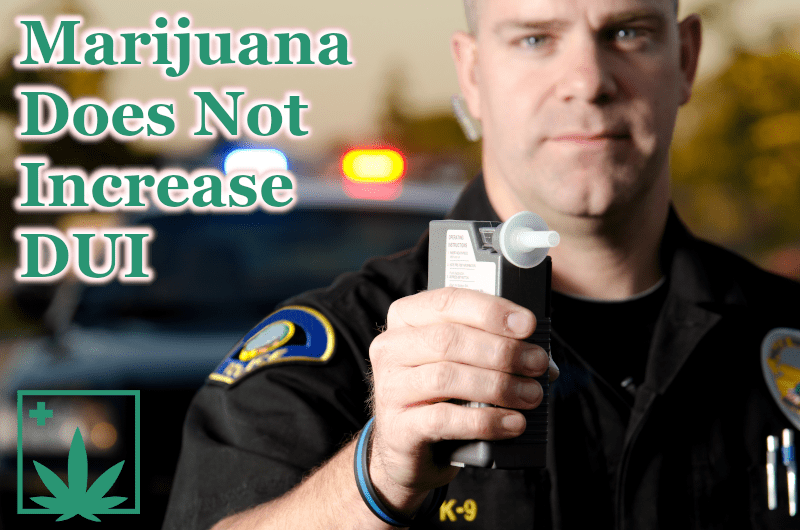
Debunking the Myth: Does Legalizing Marijuana Increase DUI’s
- A recent study by RTI International concluded that driving under the influence of cannabis does not increase in states where marijuana is legal.
- The study’s authors suggest that educational programs might be the reason and that states where marijuana is illegal should do more to educate residents on DUIC.
- Other tropes are also being debunked. Recent studies have also shown that legalizing marijuana reduces rather than increases crime rates, and also decreases the need for foster care.
One of the main rallying cries for opponents of legal marijuana was that legalization would result in an increase in marijuana users driving while intoxicated. However, the reality is that it’s turning out to have the exact opposite effect according to a new report in the journal Preventive Medicine.
Researchers at nonprofit RTI International concluded that programs to reduce driving while high are “most needed in states without legalized cannabis.”
About the study
Because it would be difficult to collect data on this matter, the study was based on self-reported data. The survey showed that people are actually less likely to drive within three hours of consuming marijuana in states where the plant is legal.
The authors of the study had this to say:
“The risk of self-reported DUIC was significantly lower in recreational and medical states than in neither states. Current cannabis users in recreational and medical only cannabis states were significantly less likely to report driving within three hours of getting high in the past 30 days, compared to current users living in states without legal cannabis.”
Paul Armentano, the Deputy Director of NORML said the study’s findings “ought to reassure those who feared that legalization might inadvertently be associated with relaxed attitudes toward driving under the influence.”
Why are we seeing this result?
The difference may be due to the fact that there are more public education programs in states where marijuana has been legalized.
The report states:
“One potential explanation for lower prevalence of DUIC in legal states is perceived safety of cannabis use, which is associated with DUIC and varies by legalization. In legal states, cannabis users may receive more information about the risks of cannabis use from sources like physicians who issue medical cannabis cards or dispensary staff than users living in neither states.”
Labeling requirements might be another factor. Cannabis products sold in states where marijuana is legal contain warnings that caution drivers against driving while using cannabis.
“States that have not legalized cannabis cannot regulate the labeling of cannabis products, while many recreational and medical states require warning labels and instructions on products. Some edible cannabis products contain warnings about driving within a few hours of consumption.”
Study recommendations
The most likely explanation for the difference is in public awareness of the problem. As such, researchers recommend implementing similar educational programs in states where marijuana is still illegal.
“Because regulation of cannabis products in non-legal environments is not possible, mass media campaigns may be a good option by providing education about DUIC. Although all states should educate its citizens about the potential dangers of using cannabis and driving, this analysis suggests that states without legal cannabis are particularly in need of DUIC prevention efforts.”
This is exactly the opposite of the recommendations in a large-scale infrastructure bill passed late last year. The bill included an amendment that encourages states that have legalized marijuana to do more to educate people about impaired driving. The amendment was criticized by cannabis policy reform advocates for singling out states with cannabis industries.
There have been some federal programs to educate Americans on DUIC. Last year, the National Highway Traffic Safety Administration (NHTSA) released a PSA that featured a cheetah smoking a joint while driving. And in 2020, NHTSA aired a TV ad telling people they shouldn’t drive while impaired even if they’re being chased by a psychopathic ax murderer.
Is all the fuss warranted about Cannabis and DUI's?
There is currently no evidence to support the idea that DUIC results in a higher propensity for accidents. Again, the opposite seems to be true.
A 2019 study reported that driving with THC blood concentrations of two to five nanograms of THC per milliliter of blood did not increase the likelihood of having an accident. And a more recent study found that smoking marijuana with higher levels of CBD had “no significant impact” on driving ability, even when participants exceeded the legal limit for THC in their blood.
Additionally, a report published in 2019 by the Congressional Research Service claimed that:
“Studies of the impact of marijuana consumption on a driver’s risk of being involved in a crash have produced conflicting results, with some studies finding little or no increased risk of a crash from marijuana usage.”
The idea that people are more likely to drive while using cannabis or more likely to get into an accident isn’t the only trope to be debunked.
Recent studies have shown that legalizing marijuana reduces the need for foster care, and that smoking marijuana does not sap users’ motivation. Also, studies show that legalizing marijuana reduces crime rates.
It looks like, one by one, the dominoes set up by the Reefer Madness contingent to strike fear into the hearts of Americans have been steadily falling.










